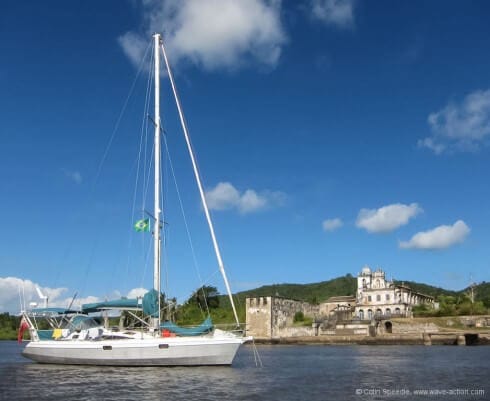
Our decision to make Salvador our landfall in Brazil was due to a mix of the prosaic and the profound. In practical terms, it’s an easy port to enter, it is strategically well placed for arrivals at this time of year bound further south, and once you’re rested up after the Atlantic, the winds and currents are favourable to carry you down the coast to Rio and beyond, in the best of the Brazilian summer.
From a historic perspective, you’re sailing in the wake of Amerigo Vespucci (1501) to the original capital of Brazil (1549) and into the heartland of the Portuguese empire of sugar cane and tobacco.
Salvador de Bahia
The old city of Salvador perches along the northern shore at the entrance of a huge bay, the Baia de Todos os Santos, filled with islands of all sizes. The vast city of high rise buildings that forms the new Salvador sprawls for miles in every direction from the Bay and it is Brazil’s third largest city, home to over three million people.
From its earliest days it has been known for its mix of wealth and licentiousness, and even today it has a reputation for crime, including attacks on boats anchored in the harbour area (four reported in 2012). A a result, we decided to go straight into Bahia Marina, so that we could clear in, clean the boat, ourselves and our laundry without any worry about being boarded in the night. But as we had arrived on a Friday evening, the formalities would have to wait until Monday morning, as all the official offices would be closed. As the guy at the marina laconically explained, “Here in Bahia we take the weekend seriously”.
So we whiled away a few days, decompressing from the voyage, baking in the heat and dealing with the inevitable repairs. Once cleared in, we set off to visit the historic quarter, the Pelourinho district that sits on the heights directly above the port, an area of music, dance, art, magnificent churches and buildings from the colonial era, together with the usual cast of chancers that gather around such tourist haunts. The guide book alarm bells ring wildly about this area, citing high levels of pickpockets and muggings, and I for one certainly would be very careful up there after dark, but it’s the heart of Salavdor, and not to be missed.
Soul Beats Money
As we’d always rather visit wild country than a wild part of town, we soon headed off across the Bay to Itaparica, a holiday island with beautiful beaches and sheltered anchorages. As a place to get a feel for Brazil, this isn’t a bad start, as it’s immensely popular with the locals, especially at the weekends. Now, as much as Brazilians love their weekends, they love their parties even more and they like them loud and late, so if you can’t join ‘em, you have to beat it.
Forewarned of a forthcoming techno music festival coinciding with a big bash on the sandbank we were anchored beside, we loaded up with food as fast as we could and set off in search of an older and (hopefully) quieter Brazil, up one of the main rivers that debouches into the bay, the Rio Paraguacu.
Up the Lazy River?
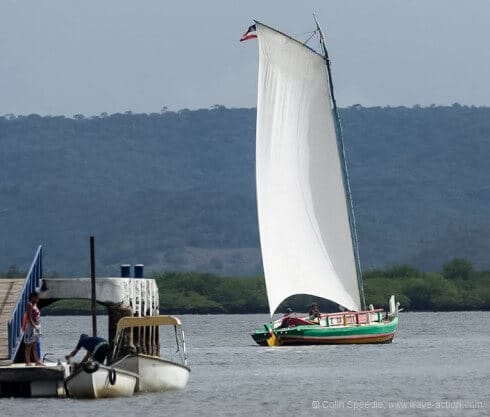
Brazil has developed into something of a petro-chemical powerhouse in recent years, and there are installations throughout the Baia de Todos os Santos. These are served by a fleet of support vessels, with a major centre just inside the Rio, where dredgers and jack up rigs are moored, lit up like a city at night.
But just around the next bend in the river, and you’re into another world, another century in fact, where fishermen paddle dugout canoes, and much of the local commerce is transported in traditional sailing craft called saveiros.

As the last of the rigs disappeared from view, we were welcomed into the Rio by a flight of scarlet ibis crossing our bow, like a row of tiny vermilion kites. We’re going to like this place, we thought.
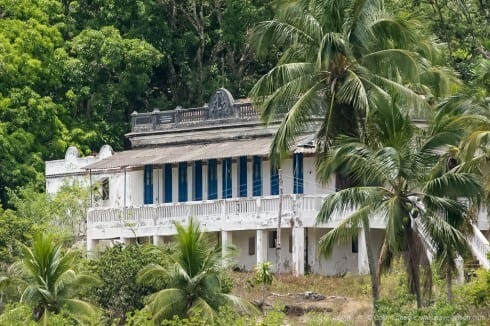
Around each bend, a further wonder appeared. Ancient forts; churches, ruined or restored; fish eagles; collapsing colonial mansions; sugar mills being reclaimed by the jungle; and peace, peace, peace. As we anchored off the jetty at the little town of Maragogipe, we felt as if we’d wandered back in time, which we didn’t mind at all.
Country People, Country Ways
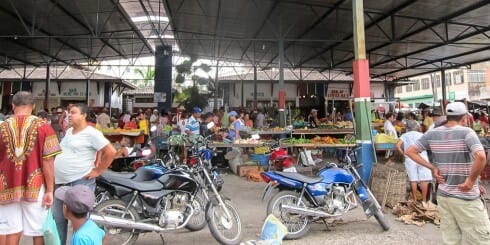
Next day was market day in Maragogipe, a spectacle in itself, as a steady string of small craft arrived at the jetty from first light, offloading goods, roosters and people to take part in the great day.
Mingling with the local people in the marketplace was a wonderful experience, not least because nobody took much notice of us, although everyone we spoke to was very friendly. Pretty much every fruit or vegetable we’ve ever seen (and quite a few we hadn’t) was on offer at country prices, so we loaded up for the next few days with things we hadn’t seen in ages, to keep us well fed while we explored the Rio at leisure.
The highlight of which was a semi-derelict convent right on the river bank, with an anchorage just below it. This turned out to be an extraordinary place, guarded by an elderly local guide armed with the biggest set of keys imaginable, like a gaoler out of Shakespeare, every one of which was put into use while he showed us around. Still in occasional use as a church (complete with plastic beach chairs for the greater comfort of the faithful) this vast complex had been entirely constructed by slaves, many of whom breathed their last in the shadow of the glory which they had created. By the time we’d seen the dungeon for the slaves who’d had the temerity to object to such harsh treatment, we’d all had a graphic reminder of the human cost of Empire, and were glad to emerge into the sunshine again.
As Night Falls
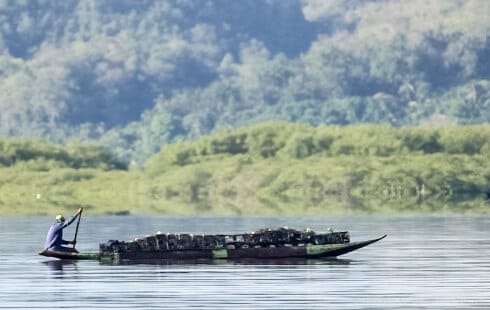
Nights at anchor off Maragogipe weren’t entirely silent, though. As the sun set, the graveyard shift of fishermen would set out with their lanterns to tend their nets and traps, keeping up a volley of cheerful banter across the river to stay in touch throughout the inky night. These simple, life affirming exchanges must have gone on ever since the first dugout took to the water, and far from being intrusive, served to remind us that even this close to ‘civilisation’ a simpler, more ancient world of human warmth and welcome still exists—to witness this was, of course, one of the main reasons we set out on our long voyage here in the first place.


Very nice writing, Colin, and a very encouraging report on a part of the world off the usual cruiser track.
Two questions: 1) How are you finding the holding in such a large river and do you use a Bahamian set-up to deal with tidal shifts (of which there may not be particularly large ones)?
2) Do you speak Portuguese or is there enough English or another language you speak to facilitate communication? I live smack in the middle of a Portuguese-dominant neighbourhood here in Toronto, and my French and Latin mean I can usually puzzle out signs and newspapers, but verbal communication is still restricted…how have you managed?
Hi Marc
Unless swinging room is very tight, we don’t Bahamian moor. However, we do on occasion, and at some stage soon I’ll write a piece on how and what gear we use.
As for Portuguese, it’s a struggle. I speak French, some Spanish and Italian, but the pronunciation of Portuguese just defeats me – still trying though. It’s rare to find a Brazilian who speaks much English, though, so I don’t feel entirely guilty!
Best wishes
Colin
Thanks, Colin. I always enjoy hearing about anchoring solutions for areas with tidal or similar reversing currents or anchoring in rivers. I docked last summer in an unfamiliar four-knot canal current and it was interesting to be giving full reverse as we threw our lines to shore to say the least. Anchoring in same would be intriguing.
Portuguese and Brazilian are linguistically diverging, or so say native Portuguese speakers to me, much as metropolitan French, dropped into rural Quebec, feel as if they’ve gone deaf in one ear. Just remember to put in a lot of superfluous “shh-zhh”s and you can speak Spanish with a cleft palate and a French accent, which is what a lot of Portuguese words sound like to me. And say “tudo bem!” a lot; it’s similar to “it’s all good, dude!”
Hi Colin,
Met two brothers and their families living on two identical self-built aluminum boats a few years ago. They’d been 2000 miles up the Amazon before ending up in the Pacific Northwest. It will be interesting to see where your wanderlust leads!
My travels in south and central America have firmly implanted the idea that public markets are the key to the soul of the country. (or is it the stomach?) Hmm- what does that say about the USA? Anyway I, like you would rather poke around in the real world instead of pretending to be part of a billionaire’s scene in Antigua or St. Barts.
Hi Richard
We love rivers and the insight they provide into the ‘soul’ of a country, although we love islands just as much.
The markets are fantastic – all life is on display, and they fascinate us. And, yes, we both very much prefer poking around in the boonies to being ripped off in Paradise – can’t afford it in any case!
Best wishes
Colin
Colin, Beautiful piece again. This one much more poetic than technical which I am enjoying.
I do agree with you and Richard regarding markets. We found the market in Cumana, VE absolutely an eye opener. The fruits and vegetables we found in the Panama City open market so fresh that some lastest for most of the 50 days up the west coast. Of course Judy did an excellent job of wrapping them carefully for dry storage.
Hi Victor
Glad you’re enjoying the pieces – thanks.
The biigest problem we find with the markets is that we load up with so much stuff we can hardly carry it back! This is solved in Maragogipe by an army of small boys with wheelbarrows who will ferry your purchases up the hill to the town (from where it’s all downhill to the river) or even take it all the way to the pontoon – saves the back!
Best wishes
Colin
Colin, Yes it is wonderful to take advantage of the local transportation system probably in use for centuries. Great way to make friends for other useful and needed tasks.
As vegetarians it is always a delight to try new fruits and vegetables including many exotic roots that are used as the base many dishes including breads. Of course there are the failures but gustatory exploration is an exciting of cruising.
I am also curious how your bottom was after a long cruise and if necessary, did you beach for cleaning? If bellow the water line was clean, I need to know what you have found that works. I had to rely on divers on several occasions on our 5,000 mile cruise up the West Coast. Perhaps some salt water organisms even have decided to part company in fresh water?
Thank you in advance for your comments.
Hi Victor
Lou is also vegetarian, and the markets are the answer for her. Otherwise, like France the snack bars and restaurant staff tend to look bemused, and say ‘madam is what?!!!!”.
Bottom paint is a real pain in these waters. Pelerin is literally covered in barnacles as I write, waiting for a diver (guess who) to start the uphill task.
We have two types of bottom paint on our hull. One, some Seajet Emperor 034 that we used last year and worked well in the Canaries, the majority Trilux 33. When we arrived both were pretty clean, but the temperature of the water here, and especially the shallow rivers coupled with not being on the move have done their worst. I’ll be writing about this at greater length later, but the Seajet succumbed first to the barnacles, soon followed by the Trilux.
Best wishes
Colin
Colin, Your replies are always so helpful. I was thinking the Jotun bottom paint I found in Curacao was the problem but now I understand that almost any paint would have a hard time with the barnacles. Diving and scrapping was relatively inexpensive compared to haul out and bottom paint. So in warm waters I guess it is the best way to go. We will see now how we do with cold water. My tendency is to see how the Inversalu (inorganic zinc silicate) which was put on the hull by the factory initially holds up on its own.
Tell Lou I did very well in France in terms of vegetarian food especially the crepes made with buckwheat (ble´noir) found in Britanny.
All the best to you both,
Victor
Hi Victor
I just dived and scraped this morning with the aid of a metal super-dooper-pooper-scooper purchased in a supermarket yesterday – perfect for the job, but took the best part of two hours, and I was knackered at the end.
As far as antifoulant is concerned I’m afraid your analysis is just about right – dive and scrape in these warm waters is the only answer. French owners with Inversalu tell me that it’s more of the same, in some places weekly is best, as it doesn’t allow ‘hard’ deposits to build up. But it does seem to have one major advantage in that is relatively robust, and so stands up well to scraping.
Sorry I can’t be the bearer of better news…..
Best wishes
Colin
Colin, Interesting about the pooper scooper. I have just used the large paint scrapper with a longish tether wrapped around the waist to keep it from falling to the bottom.
Now I know I have done no better or worse with my anti-fouling than the best of you. For the minor cost of scraping whether by others or yourself perhaps that is best solution. I am also looking forward to beaching the boat as another solution. I have pictures of the boat beached in Brazil with a hired man scrapping the barnacles. Six hours should do the job and certainly easier than diving although not cooler.
Don’t forget to retract your FLS if you decide to beach.
Enjoy!
‘ve been a follower of your site for several years. Lately though I’ve found your posting to be of less interest. Articles like ”
The New Brazil—And the Old”
are common on many sites. What attracted me to your site was it’s unique focus on Northern latitudes and boating/gear stuff for that type of cruising.
Cheers
David
Hi David
The name of the site is Attainable Adventure – which is exactly what I’m trying to portray. I’ve spent plenty of time in northern latitudes, and will do again one day. There’s just as much to see and enjoy wherever you look, if you look, and there’s plenty to learn, too, which has resonance wherever you sail.
Hopefully there’s still plenty of good material on the site for you to enjoy.
Best wishes
Colin
Hi David,
This is always the editorial challenger: how to grow, change, and improve without losing the original reader base that got you going in the first place—easy it’s not.
Having said that, I think that perhaps your disappointment is more based on perception than fact. Over the last two years we have better than doubled our content output while broadening our subject material. And we have covered an Arctic cruise, a south Newfoundland cruise and countless gear articles.
In the last few months alone we have written anchoring, storm survival and our current POB series, as well as Colin’s ocean crossing what worked piece. I’m willing to bet that there were at least as many posts that would, or at least should, be of interest to anyone heading for the high latitudes in the last two years as there were in the preceding two, and probably many more.
The point being that no publication, no matter how focused, can provide an article stream which is 100% of interest to even one reader, never mind the 23,000 unique readers that visited our site in the last 30 days.
What I would suggest you do, is subscribe to our notifications. You will then get an eMail each time we post that will give you an idea of the content. If you are interested, click on the link and enjoy, if not delete the email and get on with other things—what’s not to like?
On other point, you may not be interested in Colin’s articles on Brazil, and that’s fine. But they are not the same as that “common on many sites” for one simple reason: they are much better written.
David,
Adventure can take many forms, and doesn’t only take place in the Northern Latitudes. Just ask Mike Horn, who floated the length of the Amazon on a paddle board and circumnavigated the Arctic Circle by man-haul sledge. Or ask anyone who has immersed themselves in a totally different culture.
Hi Colin,
Really liked this piece as we are also headed to Brazil next year. The content was thus of great interest & I love your style, it really drew me in, as well as being factually full of content.
Can I ask when did you cross & from where did you jump off & when?
Kind Regards
Rolf
Hi Rolf
We crossed from the Mindelo, Cape Verdes to Salvador, leaving in mid-December and arriving in early January – you can see more by viewing the other articles in this series, sepcially the articles on the crossing itself.
Brazil has so much to offer, and is really different – sometimes it’s a challenge, but it’s well worth it.
Glad you like the piece – thanks.
Kind regards
Colin
Wonderful piece in the series, Colin.
Exploring tropical rivers represent a truly magical aspect of sail adventuring. Can you share some of your experiences regarding river navigation, like draft issues (you have an advantage there of course), reading the water and dealing with various risks? This river you’re on seems to be lumbering and large volume, and therefore rather approachable. Are you beyond the tidal zone, and seeing a few knots of current?
Here in the PNW we shoot our boats through the occasional tidal rapid, but I haven’t taken a keelboat far up a river yet. We have a lot of potential for accessing outlet rivers up this coast, so I’m always appreciative of tips.
More importantly, any unique Cachaca from the village?
Hi John
Reading the water is all important – look for swirls that may conceal snags etc. Also, I was brought up on the old adage ‘shun the point and hug the bight’. Rivers tend to scour on the outside of bends, and deposits of sand etc build up at points – works well in general.
Plus we have a forward looking sonar (Echopilot Gold FLS) which is great for this type of exploration.
We’re generally in the tidal zone, and there are very few rivers that don’t repay you by going up with the flood, and back with the ebb!
We bought some ‘unique cachaca from the village, that is mind-bending stuff – I’ll mention it in a future post – if I’ve got a memory left….
Best wishes
Colin
Excellent writing.. It was very easy to “be there with you” while reading it.. Thank you very much for a great “10 minute vacation”..
Question: You mentioned that Brazil is a “Petroleum Powerhouse”, but failed to mention the price of gas and diesel there.. Could you tell us the cost at the marinas and at stations in town.. Also, any fuel related problems since you’ve been there..??
Thank you very much..
Richard William Lord
Hi Richard
Thanks for the kind comments – I’m glad you’re enjoying the pieces.
I can’t tell you the price of gas off the top of my head, but I just paid R2.05 per litre for diesel at the fuel dock here at Vitoria. Expect to pay less at at gas station – but then you have to carry it back to the boat….
No fuel problems, thank goodness, but (a) we only buy fuel where we can expect there to be a high turnover of fuel, (b) I always buy in cans (if possible) even though it’s more work, as I can then put it into the tanks through a Baja filter, and can monitor the fuel condition.
Some people say that a lot of the diesel has all sorts of different ingredients and it certainly smells strange. Some also claim that the best is from Petrobras, but I have no way of knowing – but so far, so good.
Best wishes
Colin
Keep it comming, a lot of good info from different places, Thanks a lot.
and sail safe.
Hi,
Did you happen to see any large orange dice out on thé sea? Have you heard any news about them during your Trans Atlantic trip?
Thanks for your help.
Best,
Max